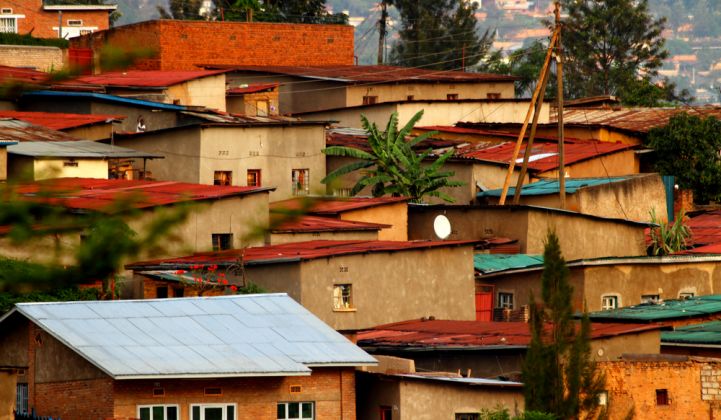The Rwandan government has partnered with Ignite Power to provide rooftop solar to 250,000 households by 2018.
The initiative expands on a successful pilot that started in 2014. Rwanda has a goal of bringing electricity to 70 percent of households by 2018, an increase from about 20 percent in 2014.
Ignite Power will provide the financing for the $50 million project, according to Climate Action. Customers will pay on average about $5 per month for a rent-to-own model in which they will get a solar system that can power some lights, a radio and a television, and cell phones.
The households will be a mix of completely off-grid homes and also homes that are at the edge of the grid.
The electrification project is part of Rwanda’s Vision 2020, which seeks to increase power generation from 185 megawatts to more than 500 megawatts in the next few years. Power Africa estimates Rwanda currently has approximately 10 megawatts of solar.
A key to advancing Rwanda’s energy infrastructure is moving away from biomass -- particularly wood -- which still accounts for more than 80 percent of energy generation in the country. That is already a considerable drop from nearly 100 percent in 2000. The country has a goal of bringing energy generation based on wood consumption down to 50 percent by 2020.
Rwanda has already had some early success with electrification, although it was starting from very humble beginnings. The country increased access to electricity from 6 percent to 16 percent between 2009 and 2012, according to the World Bank, which helped fund the effort.
Ignite Power is not alone in building a residential solar empire in Rwanda. Other rooftop solar companies such as BBOXX, Azuri, and Off Grid Electric are also entering or already working in the country of more than 11 million people. Off-Grid Electric raised $70 million in 2015 alone.
The residential solar companies operating in Africa are leveraging micro-leasing solar platforms and mobile payments to make rent-to-own systems a possibility. The systems can usually be paid for in about two years, as is the case with Ignite Power’s solution. In many regions of sub-Saharan Africa, the cost of the solar system is less than what people are paying for dirtier forms of fuel used for light, usually kerosene.
Power Africa, the U.S. government’s effort to add 30 gigawatts of power to Africa by 2030, has in some way supported most of the companies expanding into sub-Saharan Africa in recent years. The commitment of $7 billion by the U.S. in 2013 has leveraged nearly $43 billion from public- and private-sector partners.
At a Power Africa summit in Washington, D.C. in January, the initiative outlined how it will get to 30 gigawatts and 60 million new grid connections and scale up deal flow for on- and off-grid power solutions.
“Power Africa is breaking the logjam on energy infrastructure and keeping eager capital flowing to worthy projects," Gayle Smith, administrator for U.S. Agency for International Development, said in a statement. Nearly half of those grid connections are expected to be met through off-grid clean energy solutions and microgrids.
Power Africa also launched a tracking tool that records energy transactions across the continent and is meant to provide more transparency for stakeholders and potential investors.



